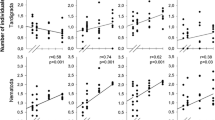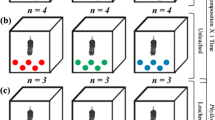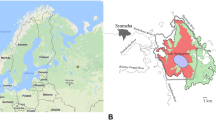Abstract
Aquatic metazoan communities in treeholes and bamboo stumps were studied on Tsushima Island, Japan, in March and June in relation to the habitat size and the resouce amount. The amount of leaf detritus increased with an increase in the capacity (volume) of the phytotelma. The input rate of leaves depended upon the opening area of the phytotelma. Twenty-one metazoan inhabitant taxa consisted of 17 dipteran saprophages, a helodid beetle larva, a nematoda, a naidid, and a predator,Toxorhynchites towadensis mosquito larva. Treeholes harbored 17 taxa and bamboo stumps 20; 16 taxa were common in both phytotelmata. The number of taxa and the biomass of metazoa per phytotelma was positively correlated with the capacity. The densities of dominant saprophages such as helodid, chironomid, andCulicoides larvae were positively correlated with the capacity of phytotelmata, and the variation in their abundance contributed much to the variation in the species composition in individual phytotelmata. With an increase in capacity, treeholes harbored more helodids andCulicoides, whereas bamboo stumps harbored more chironomids andDasyhelea. Thus, the amount of resource, species richness and biomass per phytotelma largely depended upon the capacity, and the difference in community structure between treeholes and bamboo stumps was attributable to the differential colonization patterns of different taxa.
Similar content being viewed by others
References
Bradshaw, W. E. and C. M. Holzapfel (1983) Predator-mediated, non-equilibrium coexistence of tree-hole mosquitoes in southeastern North America.Oecologia 57: 239–256.
Bradshaw, W. E. and C. M. Holzapfel (1986) Habitat segregation among European tree-hole mosquitoes.National Geographic Research 2: 167–178.
Bradshaw, W. E. and C. M. Holzapfel (1988) Drought and the organization of tree-hole mosquito communities.Oecologia 74: 507–514.
Jenkins, B., R. L. Kitching and S. L. Pimm (1992) Productivity, disturbance and food web structure at a local spatial scale in experimental container habitats.Oikos 65: 249–255.
Kitching, R. L. (1983) Community structure in water-filled treeholes in Europe and Australia—comparisons and speculations. pp. 205–222.In J. H. Frank and L. P. Lounibos (eds.)Phytotelmata: terrestrial plants as hosts for aquatic insect communities. Plexus, Medford, New Jersey.
Kitching, R. L. (1987a) Spatial and temporal variation in food webs in water filled treeholes.Oikos 48: 280–288.
Kitching, R. L. (1987b) A preliminary account of the metazoan food webs in phytotelmata from Sulawesi.Malayan Nature Journal 41: 1–12.
Kitching, R. L. (1990) Foodwebs from phytotelmata in Madang, Papua New Guinea.The Entomologist 109: 153–164.
Kitching, R. L. and R. A. Beaver (1990) Patchiness and community structure. pp. 147–176.In B. Shorrocks and I. R. Swingland (eds.)Living in a patchy environment. Oxford University Press, Oxford.
Kitching, R. L. and S. L. Pimm (1985) The length of food chains: phytotelmata in Australia and elsewhere.Proceedings of the Ecological Society of Australia 14: 123–139.
Lawton, J. H. (1989) Food webs. pp. 43–78.In J. M. Cherrett (ed.)Ecological concepts. Blackwell, Oxford.
Pimm, S. L. and R. L. Kitching (1987) The determinant of food chain length.Oikos 50: 302–307.
Pimm, S. L., J. H. Lawton and J. E. Cohen (1991) Food web patterns and their consequences.Nature 350: 669–674.
Sota, T., M. Mogi and E. Hayamizu (1994) Habitat stability and the larval mosquito community in treeholes and other containers on a temperate island.Researches on Population Ecology 36: 93–104.
Author information
Authors and Affiliations
Rights and permissions
About this article
Cite this article
Sota, T. Effects of capacity on resource input and the aquatic metazoan community structure in phytotelmata. Res Popul Ecol 38, 65–73 (1996). https://doi.org/10.1007/BF02514972
Received:
Accepted:
Issue Date:
DOI: https://doi.org/10.1007/BF02514972




